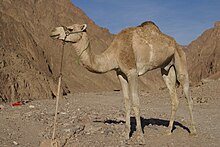 Global Information
Global InformationDromedary information
| Dromedary | |
|---|---|

| |
| Dromedary in a wadi on the Sinai Peninsula, Egypt | |
Conservation status
| |
Domesticated
| |
| Scientific classification | |
| Domain: | Eukaryota |
| Kingdom: | Animalia |
| Phylum: | Chordata |
| Class: | Mammalia |
| Order: | Artiodactyla |
| Family: | Camelidae |
| Genus: | Camelus |
| Species: | C. dromedarius
|
| Binomial name | |
| Camelus dromedarius Linnaeus, 1758
| |

| |
| range of the dromedary in 2000 | |
| Synonyms[1] | |
|
List
| |
The dromedary (Camelus dromedarius UK: /ˈdrʌmɪdəri, ˈdrɒm-/ or US: /-ˌdɛri/;[2][3]), also known as the dromedary camel, Arabian camel,[4] or one-humped camel, is a large even-toed ungulate, of the genus Camelus, with one hump on its back.
It is the tallest of the three species of camel; adult males stand 1.8–2.4 m (5 ft 11 in – 7 ft 10 in) at the shoulder, while females are 1.7–1.9 m (5 ft 7 in – 6 ft 3 in) tall. Males typically weigh between 400 and 690 kg (880 and 1,520 lb), and females weigh between 300 and 540 kg (660 and 1,190 lb).
The species' distinctive features include its long, curved neck, narrow chest, a single hump (compared with two on the Bactrian camel and wild Bactrian camel), and long hairs on the throat, shoulders and hump. The coat is generally a shade of brown. The hump, 20 cm (7+7⁄8 in) tall or more, is made of fat bound together by fibrous tissue.
Dromedaries are mainly active during daylight hours. They form herds of about 20 individuals, which are led by a dominant male. They feed on foliage and desert vegetation; several adaptations, such as the ability to tolerate losing more than 30% of its total water content, allow it to thrive in its desert habitat. Mating occurs annually and peaks in the rainy season; females bear a single calf after a gestation of 15 months.
The dromedary has not occurred naturally in the wild for nearly 2,000 years. It was probably first domesticated in the Arabian Peninsula about 4,000 years ago, or in Somalia where there are paintings in Laas Geel that figure it from 5,000 to 9,000 years ago. In the wild, the dromedary inhabited arid regions, including the Sahara Desert. The domesticated dromedary is generally found in the semi-arid to arid regions of the Old World, mainly in Africa and the Arabian Peninsula, and a significant feral population occurs in Australia. Products of the dromedary, including its meat and milk, support several North African tribes; it is also commonly used for riding and as a pack animal.
- ^ Wilson, D. E.; Reeder, D. M., eds. (2005). Mammal Species of the World: A Taxonomic and Geographic Reference (3rd ed.). Johns Hopkins University Press. p. 646. ISBN 978-0-8018-8221-0. OCLC 62265494.
- ^ "dromedary". The Chambers Dictionary (Ninth ed.). Chambers. 2003. ISBN 0-550-10105-5.
- ^ "Definition of dromedary | Dictionary.com". www.dictionary.com. Retrieved 14 February 2022.
- ^ "Arabian Camel (Dromedary) | National Geographic". Animals. 2011. Archived from the original on 3 March 2021. Retrieved 23 October 2021.